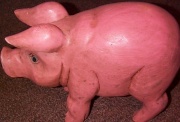Pig
From Plastic Tub
| Revision as of 17:16, 10 Apr 2005 Payne (Talk | contribs) ← Go to previous diff |
Revision as of 00:04, 11 Apr 2005 Sven (Talk | contribs) Go to next diff → |
||
| Line 47: | Line 47: | ||
| *[[The Worship of Tits]] | *[[The Worship of Tits]] | ||
| + | |||
| + | *[[Goat]] | ||
Revision as of 00:04, 11 Apr 2005
pig n. 1. Intelligent and succulent omnivore; domesticated swine. 2. Chinese Zodiac, alternatively characterized as magnanimous, yet venomous, and humble, though desirous. 3. AA totem animal (see Extrapolation, below). 4. Derogatory term for police officers and practitioners of four of the seven Deadly Sins (sloth, avarice, gluttony, and lust).
Usage
"Eat-in? More like a fucking facist pig-out." – an angry Addisson, in an apparent misunderstanding of the Massive Dinner Send-Back, 1955.
Extrapolation
Common usage and slang is generally extrapolated from the pig defined as a dirty animal and a tasty treat:
- A pig skin is a football.
- To pig out is to eat too much.
- A pig-in-a-blanket is a corndog.
The AA totem pig was famously aped by William Golding in Lord of the Flies; it's origin, however, is unclear. Gnome psy-ops tried to link it to claims of Jew-baiting, but this is doubtful.
The most obvious and common connection between the AA and pigs is a spit. Nevid Kessar once remarked that “wherever you find a dozen AAers together, heavy drinking and a pig roast can’t be far behind.” Indeed, all the annual AA gatherings as well as the 2nd and 3rd AA International Conferences have included plenty of both. For a more in depth look, readers can refer to Mazzistow Carrington and Nevid Kessar's seminal BBQ scholarship in the Auto-Colonial Bee.
A more bizarre theory was put forth in 1973 by Burt Reynolds, self-styled amateur pigologist. During a drunken encounter with Addisson and Adid, Reynolds apparently accused the AAers of being “squealing pig fuckers.” A furious Adid said he’d never squealed in his life. Addisson replied with a simple “hogwash.”
One final theory worth noting stems from Pigs and Men, the scholarly tome that is lovingly referred to as the Pig Bible by pig scholars worldwide (see Non Canonical Text, below). Nevid Kessar once avoided a fist fight with a curiously angry Iowan by sarcastically agreeing with this argument: “The AA is mysterious, and so were the Eleusianians, so what the hell, yeah, you must be right – the connection is obvious.”
As is often the case, Addisson retains the final word on the subject: “Pigs are like the Bible: you take from a pig what you bring to a pig. But sometimes, Andy, a pig is just a pig” (from a letter to Andy Rooney, pigologist and TV commentator, in 1956).
Non Canonical Text
Civilization owes a curiously underappreciated debt to the pig. The domestication of wild boar seems to go hand-in-hand with the transition from hunting and gathering societies to more sedentary agricultural communities. Indeed, current DNA evidence clearly shows that the pig was domesticated at least seven different times across the ancient Euro-Asian world, in locations stretching from Southern Europe, to Asian Minor, across the Asian steppes, and into South East Asia. Furthermore, pigs are central to religious practices in cultures spanning the globe. Of particular note to Western Civilization is the ancient Euro-Aegean custom of offering pigs to the Mother-goddess, who took the form of Demeter to the Greeks... The sacrificial pig of the pre-Christian initiation ceremonies of the Eleusinian Mysteries was only a step away from the sacrifical lamb of Christian mythology. Many secret societies continue to hearken back to the Mystery ceremonies, including, for example, the AA pig totem… In addition to religion, the pig has played an important role in war. The trifecta of ancient European trickster war strategies, for example, included the Trojan Horse, the Wolf in Sheep’s Clothing, and the Tossed Pig, which famously saved the city of Carcassonne.
|
Oppositional Groupings and Secret Orders |
- Andy Rooney, Pigs and Men, 1948 (updated in 2003), Columbia University Press.

